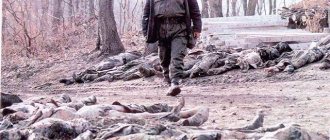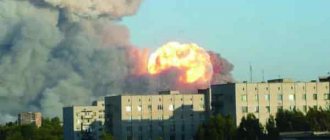...Well, let’s say an ICBM warhead arrives at the calculated point. Or an atomic bomb dropped by parachute to the height where, to put it popularly, it was absolutely necessary to go off. How does it even feel to bang? What happens in the bomb body during the instant when it and its contents turn into energy?
No, I don’t need here about the “flash from the left”, about “feet at the epicenter” and other banter based on a badly memorized civil defense textbook. What exactly happens under the casing of a thermonuclear warhead while this casing still exists - at least conditionally and partially?
Leave me alone with your repentance, this is such beautiful physics! (Laßt mich in Ruhe mit euren Gewissensbissen, das ist doch so schöne Physik!)
So said Enrico Fermi before the first nuclear tests at Alamogordo, July 1945. (If, of course, you believe the author of the book “Brighter than a Thousand Suns,” Robert Jung. There is not the slightest reason to believe him, but the phrase is still a good one, and we will use it cynically.)
First nuclear weapon test July 16, 1945
We will consider a two-stage ammunition made according to the Teller-Ulam scheme. In the Soviet Union, it is widely known as the “third idea” from the memoirs of Andrei Sakharov, although its real “fathers” in our Palestines were a whole platoon - at least Davidenko, Frank-Kamenetsky, Zeldovich, Babaev and Trutnev. Therefore, it would be wrong to attribute it personally to Comrade Academician Sakharov, as is sometimes done. (Comrade Academician also did not attribute anything unnecessary to himself. Be like Comrade Academician.)
Kiloton lighter
It all starts with the first stage - the so-called trigger. This is a simple atomic charge (well, maybe not quite simple), and everything in it starts with the simultaneous detonation of a conventional explosive charge, cunningly wrapped around a fissile substance.
In the ancient times of the atomic era, it was important that the detonators fire strictly simultaneously, with minimal mismatch - within tens of nanoseconds. Otherwise, there will be a small ordinary explosion with a quickly extinguished nuclear reaction (the so-called “fizzy”). He will pollute the entire neighborhood with wasted plutonium and other radioactive trash. In the end, they came up with a cunning version of the explosion, the so-called “swan”. In it, synchronicity is not critical, and you don’t have to cover the entire surface with detonators.
Hydrogen bomb diagram
A specially prepared explosive explodes and puts pressure on the tamper (the pusher - the heavy shell of the trigger). It “falls” inside through a void, in the center of which, surrounded by a beryllium neutron reflector, hangs the most interesting thing: a small ball of plutonium-239. The tamper compresses the ball, bringing the pressure to several million atmospheres, and transfers it to a supercritical state.
Attention: several tens of microseconds have already passed since the launch of the detonators, and yet there is no nuclear reaction yet. But now it will.
The movie has finally slowed down, and then everything will go much faster.
At the moment the plutonium nucleolus is compressed, the “fuse” is triggered: the starting source begins to drive neutrons into the nucleus.
Here she is, o: this is where all the fun begins.
The first fission of plutonium began, still under the influence of an external flow of neutrons. A few additional nanoseconds, and the next wave of neutrons, already “own” ones, began to spake in the thickness of the plutonium.
Congratulations, ladies and gentlemen, we have a chain reaction ahead of us. You have been warned.
The pressure in the center already reaches a billion atmospheres, the temperature is confidently moving towards 100 million degrees Kelvin. What's going on outside this little ball? Was there a normal explosion there? So he is. It’s hanging, excuse the verb, holding this entire structure through a tamper so that it doesn’t immediately run away, but its strength is running out.
It all ends here: after one ten-millionth of a second from the moment “zero” (0.1 microseconds, but all figures are very approximate), the reaction in plutonium is completed.
Substitute the bucket
It seems like everything has happened, a nuclear explosion has taken place, shall we part ways? Well, theoretically yes. But if you leave everything as is, the explosion will not be very powerful. It can be strengthened (boosted) with layers of thermonuclear fuel. There is really one problem. There’s a shock wave hanging there, it’s already coming apart at the seams, I’m tired of holding your nuclear bomb. How to burn it all before it runs away? You build seventeen floors, five will react, we live on that two percent, and the rest is a carpet across the countryside? No, let's think.
LGM-118 Peacekeeper ICBM warheads on the last leg of the trajectory
As Teller wrote in support of his idea, somewhere 70-80% of the energy of a nuclear reaction is released in the form of X-rays, which moves much faster than the fragments of plutonium fission exploding outward. What does this give to the inquiring mind of a physicist?
And let’s, says the physicist, before the blast wave reaches us and everything scatters to the edrene-fen, we use the X-ray that has already left the trigger to ignite the thermonuclear reaction.
Let's put a bucket of liquid deuterium nearby (as Teller had in his first product) or solid lithium deuteride (as Ginzburg proposed in the Union), and use the trigger explosion as a lighter, or, if you want, as a detonator for a REAL EXPLOSION.
No sooner said than done. Now the design of our charge is clear: a hollow tank, at one end there is a trigger, the entire lowness of which we have already discussed. The space between the first and second stages is filled with various clever X-ray-permeable materials. Everywhere it is officially stated that at first it was polystyrene foam. But since the late 1970s, the Americans, for example, have been using a very secret material called FOGBANK - presumably airgel. The filler protects the second stage from early overheating, and the outer charge body from rapid destruction. The housing also applies pressure to the second stage and generally contributes to the symmetry of compression.
In addition, there - in a short break between the first and second - there are very cunning and completely secret structures installed, about which they try not to write anything at all. They can be carefully called X-ray concentrators. All this is needed so that the X-ray does not just shine into space, but properly reaches the second stage.
The rest of the space is occupied by the second stage. Her package is also not easy, but what a package you need. In the very core of this lithium deuteride cylinder, packaged in a durable heavy casing, a channel was made into which a rod of the same plutonium-239 or uranium-235 was insidiously inserted.
If you are at the epicenter, the explosion will destroy you
Anyone at the epicenter of the explosion—the point directly above or below the detonation—is unlikely to survive. According to Brooke Buddemeier, a health physicist at Lawrence Livermore National Laboratory, the only people who could walk through a nuclear explosion at such close range are those in a fortified building or underground bunker.
If you are unlucky enough to be in one of these safe locations and you are still within a few kilometers of the bomb, your body will instantly be reduced to its essential minerals by the explosion. It can reach up to 300,000 degrees Celsius - 300 times hotter than the temperature used to cremate human bodies.
Luckily, this will happen so quickly that you won't even notice it happening.
When the Motherland needs it, the stars light up
The X-ray has evaporated the filler, is reflected from the inside from the outer shell and acts on the body of the second stage. And in general, to be honest, this entire fair is already beginning to eliminate the bomb itself as a material structure. But we will make it in time, we only need nothing, about a microsecond.
Everything that has evaporated rushes into the center and with terrible force presses and heats (millions of degrees, hundreds of millions of atmospheres) the outer shell of the second stage. It also begins to evaporate (ablation effect). Well, how to evaporate...
A jet engine in afterburner compared to this is an attempt to delicately blow your nose.
From here you can estimate the pressure on what is inside the shell. See above about the tamper on the first stage, the idea is somewhat similar.
The second stage is reduced in size - by 30 times for the cylindrical version and by about 10 for the spherical one. The density of the substance increases by more than a thousand times. The internal plutonium rod is brought to supercriticality and a nuclear reaction begins in it - already the second in our ammunition in the last microsecond.
So, the tamper was compressed on top, there was a hard bomb inside, a flow of neutrons began - and we have wonderful weather inside.
Hello, synthesis of light nuclei, lithium into tritium, all together into helium, here it is, the power output. Hundreds of millions of degrees, like in stars. The thermonuclear bomb has arrived.
A microsecond drips, the ignited lithium deuteride burns from the center outwards... wait, what if we still don’t have enough power?
Let's rewind a little and organize the second stage body not just like that, but from uranium-238. In fact, from natural metal, or even from depleted metal.
From the synthesis of light nuclei, we have a stream of very fast neutrons, they rush from the inside onto the under-evaporated uranium tamper and - oh, miracle! - a nuclear reaction is started in this harmless isotope. It is not chain-like and cannot self-sustain. But so many of these neutrons fly out of the thermonuclear reactor that they are enough for a ton of uranium: the entire second stage works like a huge neutron source.
This is the so-called “Jekyll-Hyde reaction”. That’s why the name is like this: he didn’t touch anyone, he seemed to be normal, and then SUDDENLY it’s on you.
Radiation
One of the biggest long-term consequences of a nuclear explosion is radiation, not just what is deposited during fallout. If you are close to the initial explosion and survive, it means you are contaminated by radiation.
Radiation can cause chemical changes in your DNA in high enough doses, and if you are close to a nuclear explosion, these levels can be lethal, damaging or killing your cells. Radiation can cause immediate burns (including fatal ones) and can also lead to cancer.
It hatched
Let us remind you that not even two microseconds have passed, and so many important things have already been done: they detonated an atomic bomb, ignited thermonuclear fuel with its help and, if necessary, forced the apolitical indifference - uranium-238 - to fission. The latter, by the way, is important: it can greatly overclock the power of the device. But a lot of dirt will also fly into the environment.
True, this is where the “beautiful physics” of the giants of scientific thought of the mid-20th century ends. Now all this primordial element is ready to pour out, beyond the illusory boundaries of what until recently was the body of a bomb.
And there the fireball begins to develop further, and then the damaging factors of a nuclear explosion arise. But more about them later.
Consequences of a nuclear explosion
Damaging factors.
When a nuclear weapon is detonated, a nuclear explosion occurs, the damaging factors of which are:
*shock wave
*light radiation
*penetrating radiation
*radioactive contamination
*electromagnetic pulse (EMP)
*X-ray radiation
People directly exposed to the damaging factors of a nuclear explosion, in addition to physical damage, experience a powerful psychological impact from the terrifying sight of the explosion and destruction. An electromagnetic pulse does not have a direct effect on living organisms, but can disrupt the operation of electronic equipment.
Radioactive contamination is the result of a significant amount of radioactive substances falling out of a cloud lifted into the air. The three main sources of radioactive substances in the explosion zone are fission products of nuclear fuel, the unreacted part of the nuclear charge, and radioactive isotopes formed in the soil and other materials under the influence of neutrons (induced radioactivity).
As the explosion products settle on the surface of the earth in the direction of movement of the cloud, they create a radioactive area called a radioactive trace. The density of contamination in the area of the explosion and along the trace of the movement of the radioactive cloud decreases with distance from the center of the explosion. The shape of the trace can be very diverse, depending on the surrounding conditions.
The radioactive products of an explosion emit three types of radiation: alpha, beta and gamma. The time of their impact on the environment is very long.
Due to the natural decay process, radioactivity decreases, especially sharply in the first hours after the explosion.
Damage to people and animals due to radiation contamination can be caused by external and internal radiation. Severe cases may be accompanied by radiation sickness and death.
A nuclear explosion in a populated area, like other disasters associated with a large number of casualties, destruction of hazardous industries and fires, will lead to difficult conditions in the area of its effect, which will be a secondary damaging factor. People, even those who have not received significant injuries directly from the explosion, are likely to die from infectious diseases [7] and chemical poisoning. There is a high probability of getting burned in fires or simply getting hurt when trying to get out of the rubble.
A nuclear attack on a nuclear power plant could release significantly more radioactive material into the air than the bomb itself could produce. In the event of a direct hit by a charge and evaporation of a reactor or storage facility for radioactive materials, the area of land uninhabitable for many decades will be hundreds to thousands of times larger than the area of contamination from a ground-based nuclear explosion. For example, with the evaporation of a 100 MW reactor by a 1 megaton nuclear explosion and simply with a 1 Mt ground nuclear explosion, the ratio of areas of territory with an average dose of 2 rad (0.02 Gray) per year will be as follows: 1 year after the attack, 130,000 km? and 15,000 km? in 5 years 60,000 km? and 90 km? in 10 years 50,000 km? and 15 km? in 100 years 700 km? and 2 km?[8].
Penetrating radiation (ionizing radiation) is gamma radiation and a flux of neutrons emitted from the nuclear explosion zone for units or tens of seconds.
The damage radius of penetrating radiation during explosions in the atmosphere is smaller than the damage radii from light radiation and shock waves, since it is strongly absorbed by the atmosphere. Penetrating radiation affects people only at a distance of 2-3 km from the explosion site, even for large-power charges, but a nuclear charge can be specially designed in such a way as to increase the proportion of penetrating radiation to cause maximum damage to manpower (the so-called neutron weapon). At high altitudes, in the stratosphere and space, penetrating radiation and electromagnetic pulse are the main damaging factors.
Penetrating radiation can cause reversible and irreversible changes in materials, electronic, optical and other devices due to disruption of the crystal lattice of the substance and other physical and chemical processes under the influence of ionizing radiation.
Protection against penetrating radiation is provided by various materials that attenuate gamma radiation and neutron flux. Different materials react differently to these radiations and protect differently.
Materials containing elements with high atomic mass (iron, lead, low-enriched uranium) are well protected from gamma radiation, but these elements behave very poorly under neutron radiation: neutrons pass through them relatively well and at the same time generate secondary capture gamma rays, and also activate radioisotopes, making the protection itself radioactive for a long time (for example, the iron armor of a tank; lead does not exhibit secondary radioactivity). Example of layers of half attenuation of penetrating gamma radiation[4]: lead 2 cm, steel 3 cm, concrete 10 cm, masonry 12 cm, soil 14 cm, water 22 cm, wood 31 cm.
Neutron radiation, in turn, is well absorbed by materials containing light elements (hydrogen, lithium, boron), which scatter and absorb neutrons efficiently and with short range, while not being activated and emitting much less secondary radiation. Layers of half attenuation of the neutron flux: water, plastic 3 - 6 cm, concrete 9 - 12 cm, soil 14 cm, steel 5 - 12 cm, lead 9 - 20 cm, wood 10 - 15 cm. Hydrogen absorbs neutrons best of all materials (but in the gaseous state it has low density), lithium hydride and boron carbide.
There is no ideal homogeneous protective material against all types of penetrating radiation; to create the lightest and thinnest protection possible, it is necessary to combine layers of different materials to sequentially absorb neutrons, and then primary and capture gamma radiation (for example, multi-layer armor of tanks, which also takes into account radiation protection; protection of the heads of mine launchers from containers with lithium and iron hydrates with concrete), as well as the use of materials with additives. Concrete and moistened soil backfill, widely used in the construction of protective structures, containing both hydrogen and relatively heavy elements, are universal. Concrete with the addition of boron is very good for construction (20 kg B4C per 1 m2 of concrete), with the same thickness as ordinary concrete (0.5 - 1 m), it provides 2 - 3 times better protection against neutron radiation and is suitable for protection against neutron weapons[5].
4.Bilateral nuclear weapons agreements
As attempts to contain nuclear weapons continued in various international forums, there was a growing consensus that nuclear powers had a special responsibility for maintaining a stable and secure system of international security. During the Cold War and its aftermath, both major nuclear powers entered into agreements that significantly reduced the threat of nuclear war.
Conclusion.
Scientists believe that with several large-scale nuclear explosions, resulting in the burning of forests and cities, huge layers of smoke and burning would rise to the stratosphere, thereby blocking the path of solar radiation. This phenomenon is called “nuclear winter”. Winter will last for several years, maybe even just a couple of months, but during this time the Earth's ozone layer will be almost completely destroyed. Streams of ultraviolet rays will pour onto the Earth. Modeling of this situation shows that as a result of an explosion with a power of 100 kt, the temperature at the Earth's surface will drop on average by 10-20 degrees. After a nuclear winter, the further natural continuation of life on Earth will be quite problematic:
• there will be a shortage of nutrition and energy. Due to severe climate change, agriculture will decline, nature will be destroyed or greatly changed.
• radioactive contamination of areas will occur, which will again lead to the destruction of wildlife
• global environmental changes (pollution, extinction of many species, destruction of wildlife).
Nuclear weapons are a huge threat to all humanity. Thus, according to the calculations of American experts, an explosion of a thermonuclear charge with a power of 20 Mt can level all residential buildings within a radius of 24 km and destroy all life at a distance of 140 km from the epicenter.
Considering the accumulated stockpiles of nuclear weapons and their destructive power, experts believe that a world war using nuclear weapons would mean the death of hundreds of millions of people, turning into ruins all the achievements of world civilization and culture.
Fortunately, the end of the Cold War has somewhat eased the international political situation. A number of agreements have been signed to stop nuclear testing and nuclear disarmament.
Another important problem today is the safe operation of nuclear power plants. After all, the most ordinary failure to comply with safety regulations can lead to the same consequences as a nuclear war.
Today people must think about their future, about what kind of world they will live in in the coming decades.
Used Books:
https://ru.wikipedia.org
https://www.fas.org/programs/ssp/nukes/nuclearweapons/nukestatus.html
Robert Jung.
"Brighter than a thousand suns." M, 1960
Ponomarev, Leonid Ivanovich, “Under the sign of the quantum”, 1984 (1989, 2007) Atomic bomb. (chapter from the book)
Nuclear weapons: a complete encyclopedia.









